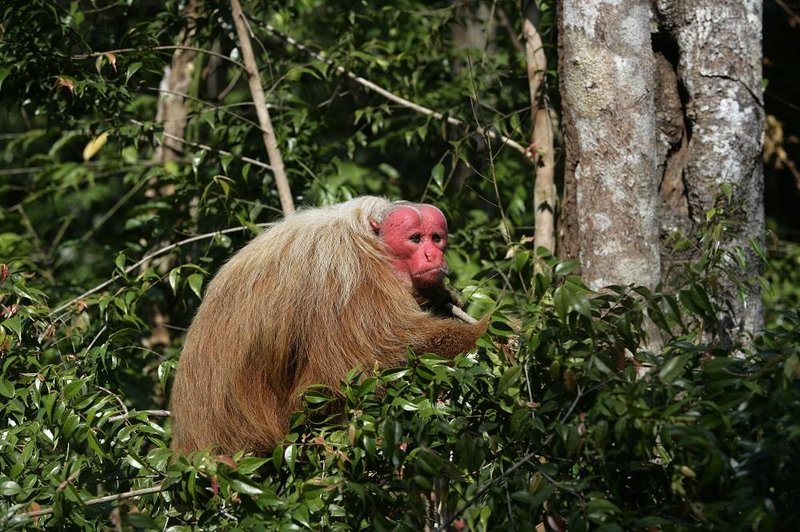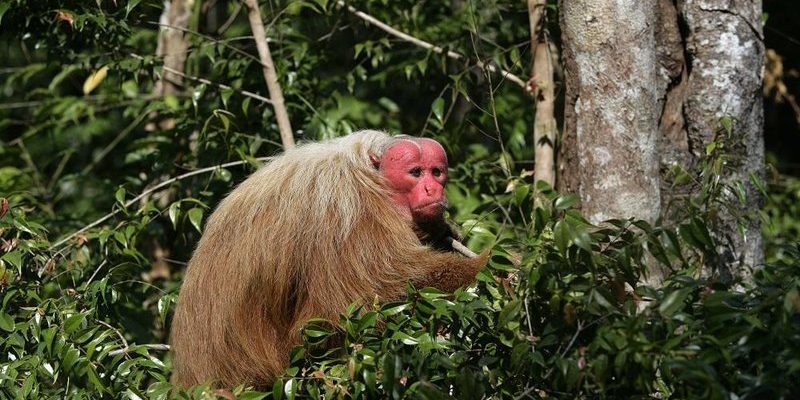
Uakaris are quite remarkable, but their unique lifestyles might leave you wondering: how do they manage to thrive where others might struggle? Let’s dive into their clever adaptations, social structures, and diet choices that allow them to not just survive, but flourish in the wild.
Understanding Uakaris’ Habitat
Uakaris primarily live in the flooded forests of the Amazon, primarily in Brazil and Peru. The environment here is anything but ordinary, with waters rising and falling dramatically throughout the seasons. The dense canopies provide shelter, but they also make it challenging to find food during high-water periods.
You might picture Uakaris swinging through the treetops like acrobats, dodging raindrops as they move. That’s part of their charm! They are well-adapted to the * flooded ecosystem*, using their long limbs to traverse from branch to branch despite the floodwaters below. This unique habitat influences their daily routines, including feeding, foraging, and even social interactions.
One of the most intriguing aspects of Uakaris’ environment is how they’ve developed life strategies around it. For example, during droughts, they can be found moving to higher ground or more stable forests. This flexibility showcases their intelligence and adaptability, essential traits for survival in such a fluctuating ecosystem.
Diet: Mastering Nutritional Needs
When it comes to food, Uakaris are true specialists. They primarily feast on fruits, seeds, and nuts, with an emphasis on fruits due to their high-water content—a real bonus during the heat of the day. Imagine having access to an all-you-can-eat buffet of juicy fruits! However, their diet can change dramatically between wet and dry seasons.
During the rainy season, when foods are plentiful, they take full advantage of the variety available. Fruits like figs, which are rich in nutrients, become their go-to treats. In contrast, when water levels drop and food becomes scarce, they might switch to tougher, fibrous plants or even insects to sustain themselves. This ability to adapt their diet is crucial; it’s like having a backup plan when the first one doesn’t work out.
Another interesting point is the role of their teeth. Uakaris have evolved strong, flat teeth that can help them crush hard seeds and nuts. Without this adaptation, they wouldn’t be able to access those important nutrients. It’s a perfect example of how evolution plays a role in their survival strategies.
Physical Characteristics That Aid Survival
Uakaris are known for their unique physical features, which are not just for show. One of their most notable traits is their *facial coloration*. With bright red or brown faces, these monkeys use visual signals to communicate with each other, especially in the dense rainforest where visibility can be low.
You might be curious about why their faces are so exposed. Interestingly, this characteristic aids in social bonding within their groups. The visible expressions help them communicate emotions and intentions, giving them a social edge in navigating harsh environments. It’s like having a friendly chat with your neighbors, which strengthens their community ties and helps them work together to find food and stay safe.
Furthermore, their long tails and limbs allow them to move gracefully through their treetop homes. This agility is an essential aspect of their survival, enabling them to escape predators quickly. Picture it as a high-stakes game of hide and seek—those who can move swiftly and stealthily often come out on top.
Social Behavior and Group Dynamics
Uakaris are social creatures, often found in small troops ranging from 5 to 30 individuals. This social structure plays a significant role in survival. Living in groups provides several advantages, like increased vigilance against predators and more eyes to spot food sources.
You might wonder how they keep order among so many individuals. Well, Uakaris have a hierarchical social system that helps maintain peace within the group. Dominant individuals lead, while others have their roles, from foragers to protectors. This teamwork not only ensures everyone gets enough food but also fosters social bonds that are vital in their challenging environment.
In addition to finding food, working together helps them stay safe from potential threats. When a predator approaches, a sentinel might issue a call to alert the group, and they quickly rally to a safe, higher perch. It’s a bit like having a watchful friend who always has your back!
Adapting to Climate Changes
The Amazon rainforest is not just home to Uakaris; it’s a complex ecosystem constantly facing changes. Climate change, deforestation, and habitat loss are challenges they must navigate. But how do these monkeys adapt to such significant shifts?
One way they adapt is through *flexible foraging strategies*. When their traditional food sources are threatened, they begin to explore new areas, scouting for different plants that can serve as sustenance. This adaptability helps them survive when familiar routes become less viable.
Additionally, Uakaris have shown resilience in their breeding patterns. They can adjust their reproductive cycles based on environmental conditions. If food becomes scarce, they may delay breeding until conditions improve. This ability to time reproduction to align with availability of resources is a smart survival tactic.
However, it’s crucial to note that these adaptations aren’t foolproof. As human activities continue to encroach on their habitat, Uakaris face increasing challenges. Conservation efforts are essential to ensure these incredible animals have a fighting chance in the future.
Uakaris are more than just a unique-looking species of monkey; they are a testament to nature’s ingenuity. By thriving in one of the most challenging environments on earth, they remind us of the incredible resilience found in the animal kingdom. Their ability to adapt, forage, and work together in social groups showcases not just their tenacity but also the delicate balance of their ecosystem.
Understanding how Uakaris survive in harsh environments opens our eyes to the importance of protecting their habitat. These fascinating creatures play a vital role in maintaining the Amazon rainforest’s biodiversity. So next time you hear about the struggles of wildlife due to climate change, remember Uakaris and their clever survival strategies. They inspire us to appreciate and protect the natural world around us.

